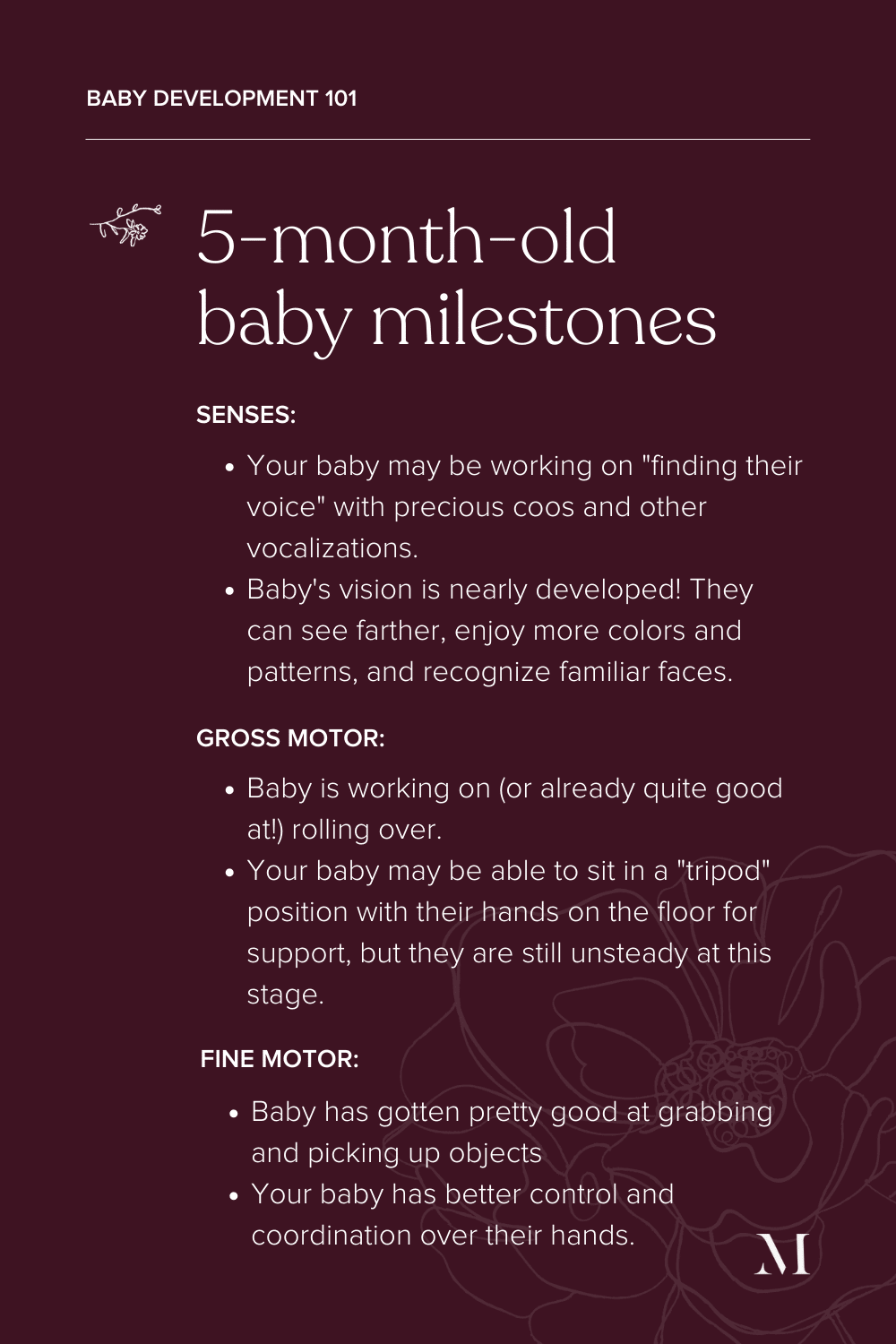5-month-old baby milestones
While every baby is different, of course, babies at this age may start to follow more regular sleep patterns.

At 5 months old, your baby is engaging with the world around them, working on the motor skills that will help them be on the move soon enough and taking mental notes about the things they observe. Yes, there may be some crying—but probably also a lot of smiles and giggles, too.
By keeping track of what milestones your baby is working on achieving, you can support their development and consult with your pediatrician if you have any questions or concerns.
5-month milestones at a glance
Some of your 5-month-old baby’s developmental milestones will be super apparent, like when they start rolling over or sit up with support. Others are less obvious, like catching onto the concept of cause and effect or object permanence, or more regularly recognizing familiar faces. Your little one may also be starting to sleep on a more regular schedule, and that consolidated night sleep may mean more wake periods during the day. Aside from more sleep for you, here’s another reason why that’s great: You can actually head out of the house without stressing about interfering with nap time. Finally!
An in-depth look at 5-month milestones
Read on to find out what you need to know about 5-month-old baby development this month to best support your little love’s growth.
5-month developmental milestones
Here’s what The American Academy of Pediatrics (AAP) says about 5-month-old baby milestones.
(Editor’s note: The 5-month milestone guidelines were written to reflect the behaviors that 50% or more of children exhibit at a certain age. Note that milestones are not a perfect metric: It’s key to speak to your pediatrician if you have concerns about your unique child.)
Senses
- After listening to your conversations for months now (even while in the womb!), your baby may be working on “finding their voice” with precious coos and other vocalizations.
- Your baby’s vision is nearly developed! They can see farther, enjoy more colors and patterns, and recognize familiar faces.
Gross motor skills
- By 5 months, many babies are working on (or already quite good at!) rolling over. Babies generally roll from stomach to back first before working on rolling back to stomach.
- With good head control and improving trunk strength, your baby may be able to sit—with support. Your baby may be able to sit in a “tripod” position with their hands on the floor for support, but they are still unsteady at this stage.
Fine motor skills
- Your baby has gotten pretty good at grabbing and picking up objects—although they won’t use the more advanced pincer grasp for another few months.
- Your baby has better control and coordination over their hands. They should be able to reach for and hold toys like rattles.
Related: When it comes to developmental milestones, earlier isn’t always better

Baby’s sleep at 5 months
While every baby is different, of course, babies at this age may start to follow more regular sleep patterns. Plus, being more awake and active during the day, exploring the world around them and working on meeting big physical milestones, like rolling over and starting to sit up, can certainly help tucker out your little love.
Still, lots of sleep should still be on the menu. As the American Academy of Sleep Medicine explains, a 5-month-old baby should get between 12-16 hours of sleep per 24 hours. This is generally divided into both nighttime sleep and around three naps during the day.
What baby sleep looks like at 5 months:
- Your baby may be taking 3 to 4 naps per day, and possibly ready to drop the fourth nap
- Your baby may be waking just once to eat at night
- Your baby may be awake for 1.5 to 2.5 hours at a time
Wondering how you’ll know when it’s time to drop a nap? There are a few signs to look out for:
- Your child’s regular naps have gotten significantly shorter for two or more consecutive weeks
- Your child has been rejecting their last nap for two or more consecutive weeks
- Your child is having trouble falling asleep at night or is rising too early
Too much daytime sleep can unfortunately affect nighttime sleep. If you have more questions, chat with your pediatrician.
Read more: How much sleep does a 5-month-old baby need?
Feeding a 5-month-old
Your hungry bub is likely a very efficient eater these days, and they’re probably starting to take in a little more at each feeding now, too. Remember that if you’re doing combination feeding, you can space out their formula bottles a bit more than their breast milk sessions—formula takes slightly longer to digest and metabolize than breast milk. Next month, you’ll be starting solids! You might want to do some reading ahead now so that it feels less daunting (we promise it doesn’t have to be).
The AAP and La Leche League (LLL) recommend the following feeding timeline and amounts for 5-month-olds:
- Breast milk: 5 to 7 ounces every 3 to 4 hours
- Formula: 5 to 6 ounces every 4 to 5 hours
Read more: 5-month-old baby feeding schedule & amounts
Activities for 5-month-olds
At 5 months, your little one is continuing to discover their world. They may be rolling, putting everything in their mouth, and playing that fun “game” of throwing toys onto the floor for you to pick up at least 36 times. It doesn’t take much to make them happy these days, and one flash of that toothless grin and you’re a puddle, surely.
Here are a few activities to do with a 5-month-old baby:
Make a magic box: Fill an empty tissue box with a few small baby-safe objects or toys that they can pull in and out easily. Silk play scarves are also a good option. The action of pulling things out of hiding is so satisfying for your little explorer—furthering their understanding of object permanence!
Break out the blocks: Though they may still be working on their stacking skills, babies at this age love to knock things down. Building a tall tower for them to push over can bring endless delight.
Make it a museum day: If there’s an art gallery or museum nearby, strap baby into a baby carrier and head out. Babies have a newfound sense of color, so they can see more shades, spot objects further away and may enjoy more patterns these days.
Related: A parent’s guide to car seat safety: Tips, rules & product picks
Supporting your 5-month-old baby’s development
Ready to make the most of those wake windows? These 5-month-old baby activities can support your cutie’s development.
- Soothe your 5-month-old baby by talking in calm, reassuring tones. With a new understanding of object permanence, your baby may feel more on edge when you walk away.
- Play with your 5-month-old baby with a special place for them to explore. These gorgeous, modern playmats inspire movement with eye-catching designs and engaging toys to reach for—and they’re chic enough to leave in your living room.
- Engage your 5-month-old baby’s senses by pointing out different sounds you hear together, like car horns or bird tweets.
Related: What every parent should know about attachment theory
It’s science: Naps help with cognitive development
At 5 months, your baby is likely still napping two to three times a day—and one or two of those are bound to be when you’re on the go. Keep in mind, research shows the importance of nap times (even for preschoolers!), so making a point to establish healthy nap habits from an early age can pay off with your child’s cognitive development. For maximized benefits, aim to allow your baby to nap in a dark, calm space as often as you can.
Related: The one thing your kid needs to get ready for kindergarten? More sleep, AAP says
A note from Motherly: 5-month milestones
Your baby is learning new skills every day. And you’re probably continually in awe of how quickly they are growing! Enjoy the little wins and tiny victories with your baby, mama, whether that’s rolling for the first time or laughing about a game of peek-a-boo.
Read ahead: 6-month-old baby milestones
A version of this story was originally published on Oct. 16, 2021. It has been updated.